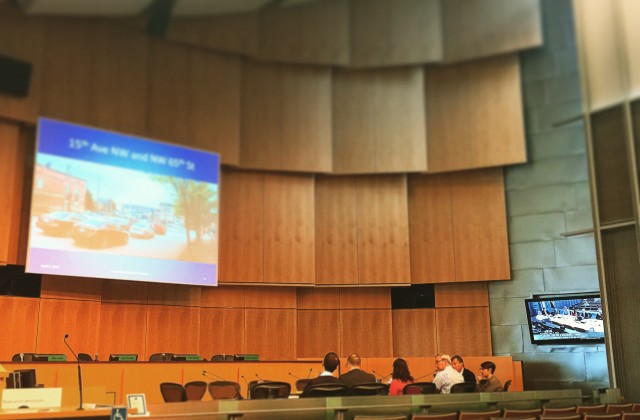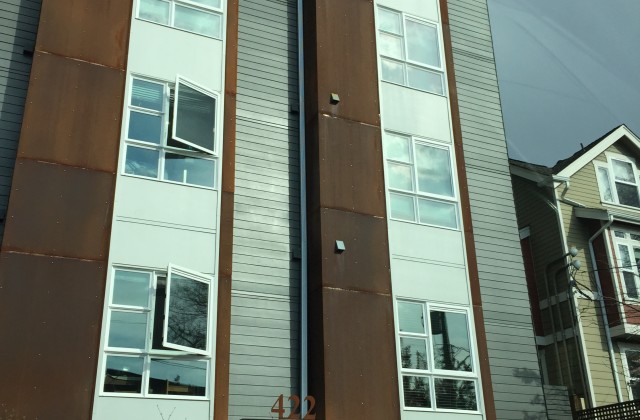Watching Pedestrian Designation Proposal
The Seattle City Council is considering expanding the number of areas that designated P or Pedestrian. Pedestrian zones are areas that have a lot of retail use concentrated in a way that allows more walking and less driving. In a way, designating more of these zones is both trying to preserve walkability and promote it. The Central Staff memo on the proposal describes P Designations this way:
The primary effect of the P designation is to require a set of retail and other lively pedestrian-oriented uses at street level along Principal Pedestrian Streets and to limit driveways along those streets. Drive-in businesses and surface parking lots are prohibited in areas with P designations. In addition, development in areas with P designations when also located in urban villages must exceed a minimum floor area ratio (FAR) limit.
The proposal, an outgrowth of regulatory reform legislation passed a few years ago, would create 37 new pedestrian designations. This isn’t bad for housing and new growth and in many ways this effort is in the best intention category. It can mean more requirements for redeveloping an existing site.
I testified this way at yesterday’s hearing on the proposal:
I was a member of the Regulatory Reform Task Force that first met four years ago in a very public and exhaustive process to identify opportunities to open up our city for more growth, especially mixing uses together in our densest neighborhoods.
We recognize this proposal is a series of trade-offs that try to accomplish this by improving the flexibility of use in dense neighborhoods. Flexibility is the key concept here and is the one we see as allowing, over time, uses to develop to meet demand for residential and commercial space.
What we are concerned about is the phrase, on page 3 of the Central Staff memo, that suggests, “restrict[ing] the ability to waive some of these regulations through design review.”
In the past the purpose of increasing the prescriptive nature of the code in some places was intended, sometimes, to create both certainty and an incentive to participate in Design Review. While many of us have issues with how Design Review is working (or not working is often the case), we wonder why the door is being closed on that process being part of the flexibility.
We suggest not having a “no departure” element to this since it tends to undermine the certainty and flexibility we sought when the Regulatory Reform Process began.
We’ll be keeping an eye on how this proposal unfolds and especially how it impacts potential new housing and retail developments in areas with the Pedestrian Designation. I’m not a big fan of design review as it is currently, but it makes more sense to allow that as an option if it makes sense that making even more unbending rules that could add costs to housing in great neighborhoods. You can see a map of the various districts here in the full Central Staff Presentation.
London Calling: Housing Regulation Takes a Human Toll
Every once in awhile I get bombarded by an article. I’ll see it posted on Facebook by multiple people in multiple places, I’ll get it in e-mails, in news aggregators, and even, if you can believe this, in hard copy (the picture is from the main lounge at We Work). Often the article ends up hitting me over the head because it says so well what many of us  have been saying over, and over, and over again. The article that I was bombed with most recently is the cover story of a recent issue of The Economist and is titled, “Poor land use in the world’s greatest cities carries a huge cost.” Last year’s microhousing debacle (and this year’s second thoughts) are sure to come to mind. Read the whole article, but here are the two best paragraphs:
have been saying over, and over, and over again. The article that I was bombed with most recently is the cover story of a recent issue of The Economist and is titled, “Poor land use in the world’s greatest cities carries a huge cost.” Last year’s microhousing debacle (and this year’s second thoughts) are sure to come to mind. Read the whole article, but here are the two best paragraphs:
Even in these great cities the scarcity is artificial. Regulatory limits on the height and density of buildings constrain supply and inflate prices. A recent analysis by academics at the London School of Economics estimates that land-use regulations in the West End of London inflate the price of office space by about 800%; in Milan and Paris the rules push up prices by around 300%. Most of the enormous value captured by landowners exists because it is well-nigh impossible to build new offices to compete those profits away.
The costs of this misfiring property market are huge, mainly because of their effects on individuals. High housing prices force workers towards cheaper but less productive places. According to one study, employment in the Bay Area around San Francisco would be about five times larger than it is but for tight limits on construction. Tot up these costs in lost earnings and unrealised human potential, and the figures become dizzying. Lifting all the barriers to urban growth in America could raise the country’s GDP by between 6.5% and 13.5%, or by about $1 trillion-2 trillion. It is difficult to think of many other policies that would yield anything like that.
But here’s what Councilmember Mike O’Brien, who has a Masters degree in Business Administration, said recently in the Ballard News-Tribune. On commercial space, he said,
Affordable commercial space is important to create and preserve business districts with local businesses. I’m committed to working with local business owners to create conditions under which local businesses can thrive throughout Seattle, and in Ballard
And what exactly is he working on and trying to impose on new development both commercial development? More regulation and fees!
I am working hard to create an affordable housing linkage fee that would require all new development in Seattle to provide affordable, rent-restricted units alongside more expensive rate market-rate units. This will allow more people to stay in Ballard as the neighborhood grows and changes.
O’Brien uses sanitized language as if the fee itself will provide the “affordable, rent-restricted” housing he’s talking about. The fee will come at the expense of renters, who, as The Economist article assures us, are the ones that end up paying for regulation, taxes, and fees, not developers. These units that will be build “alongside” market rate units will be much more expensive than the market rate ones: we know that already because government agencies acknowledge that subsidized housing is more expensive. From Washington’s own Commerce Department:
Construction costs for affordable and market-rate housing are similar, but affordable housing has more “soft costs” associated with financing and project management. Sponsors are required to maintain certain levels of contingencies and reserves, often hire outside expertise to develop or manage the project, and face more finance and regulatory requirements.
On average, affordable housing requires an average of five financing sources and takes twice as long to complete. Because local, state and federal subsidy sources often require leveraging and are awarded through separate competitive funding processes, it generally takes twice as long to assemble the financing as market-rate projects, and contributes to increased legal and other transaction costs.
Sponsors must often take out bridge loans to get interim financing while they are trying to secure permanent funds. They generally have limited internal capital and higher pre-development costs.
Hmmm. Doesn’t sound very “affordable” (or efficient) at all. And as I have pointed out before, it is regulation–the same regulation that drives up costs for market rate housing–that adds more costs to subsidized housing, meaning there is less of it built.
The difference between what is known and taught in economics at places like the London School of Economics and what local politicians actually do is like day and night. Basic economics, taught in most business schools, is pretty clear that when we expand supply to keep up with demand, the beneficiaries are customers who get lower prices because of competition. Somehow the message hasn’t gotten from London to Seattle yet. But we’ll keep trying.
DPD Says Council “Went a Little Too Far” on Microhousing
Yeah. I know. I read that headline from the Puget Sound Business Journal twice too. Was I dreaming? Nope. Here’s what the Director of Planning and Development, Diane Sugimura, said at a forum about affordable housing:
Responding to the outcry among micro-housing foes, the council last fall unanimously approved new regulations. Mini-apartment projects now can be no smaller than 220 square feet, and they have to have a certain number of sinks. Projects in some parts of the city must have some parking, and the projects must go through the design-review process, which is costly for developers but allows neighbors to weigh in on the look of proposed buildings.
Sugimura said she thinks the council went “a little too far.” City officials are hearing that “we will not get units at the $600, $700, $800 [monthly rents] like those were,” she said. “They’re probably now in the four figures.”
Um, can I say, “I told you so” now?
Here’s what we said back when we were fighting Councilmember O’Brien’s legislation las year:
As you consider legislation to further regulate micro-housing and congregate residences, please consider each specific policy decision as many have a negative effect on the availability and affordability of this workforce housing type. Together, they could effectively kill this housing type altogether.
Councilmember and candidate for re-election Tim Burgess says the Council may take up microhousing again. Where was Burgess last year? Burgess, right after he voted to end microhousing as we’d known it said not to listen to “a few [that] characterize our actions as somehow limiting options” for housing. I sent him an email challenging his rewrite of history. He wrote back.
Sorry, Roger, we disagree completely on this issue and I’m very comfortable with that.Remember last year, everyone told us that if we changed incentive zoning in SLU we would cripple development. Right.
Dear Tenant: Housing Shortage Too Severe to be Constrained by Nostalgia
I have been a landlord. And while landlords are among the least popular people in our culture and economy, somebody has to manage rental properties. Just imagine inviting 25, 60, or 100 strangers onto a property you are financially responsible for. Life happens. Parties happen. Noise happens. Abandoned furniture happens. Tragedy happens. And yes, sometimes, costs from operations and pressures from investors mean rents have to go up. And all this is true even for non-profit affordable housing like the 25 units I managed.
No landlord I know is asking for sympathy or for renters or the media to feel sorry for them. But rather, it seems to make sense, if we’re going to try to deal with housing prices to understand the role of building managers and owners and how they can be part of the solution. However, recently, the Seattle Weekly published an article written as a letter to a landlord. You can read the whole thing here. It is, in a word, sensationalistic.
A colleague of mine and a landlord, Brian Robinson, wrote what I consider to be a perfect balancing response. Robinson writes about the challenges of dealing with tenants who aren’t just rowdy college kids or people behind on their rent, but people with a myriad of issues including addiction, mental illness, and lack of resources. Landlords aren’t the people equipped to handle these complex situations, and our fraying social safety net means, often, when evicted these people become homeless, a threat to themselves and others. Robinson writes,
Extreme stories like Bill and John’s make up only a small part of our housing-affordability problem. Thousands of other renters who are not homeless or suicidal are finding themselves unable to keep up with the increasing cost of housing. They are forced to work second jobs, take in roommates, downsize their accommodations, or make other sacrifices to their quality of life that should not be necessary in a region as prosperous as ours. Many find themselves in situations like yours, where a building is sold and rents suddenly adjusted up to market value.
All of this is only going to get worse as wages continue to climb in the city. People will be able to pay more for apartments, outbidding each other and driving prices up. This will be true at both ends of the rent scale as minimum wages see a sharp increase and more high-salary tech jobs are created.
Generally speaking, landlords and building owners are as compassionate as any other group of people. And in my case, when we had a tenant similarly self-destruct in her unit, we had no choice but to evict. And we tried to address the real issues with a cross disciplinary team from multiple public agencies. Nothing worked. And as damages to the unit reached thousands of dollars, it meant our budget for repairs for other units was being drained. Our troubled tenant wasn’t just hurting herself and her family, but she was also hurting 24 other families. And they were doing their best to keep up with their rents.
What makes me livid when I read articles like the one written by the author of the original Weekly cover story, is that it doesn’t take into account the many, many background issues going on in such a complicated case. As I’ve said before, greed is a character trait not a business model. And rather than assessing blame, we need to work together to solve problems. Making it harder to build and manage rental housing doesn’t solve the human problems faced by many people in our city who are renters. And for those who simply are struggling to make ends meet it simply makes doing that more difficult. If we are going to assess blame though, Robinson points out where it lies.
If we want this growth to happen, tenants citywide should consider taking a stand against Seattle’s vocal and entrenched constituency of neighborhood preservationists. Many of these groups oppose growth and increased density because it changes the experience and character of neighborhoods for existing residents. Our housing shortage is too severe to be constrained by nostalgia. We need to ask existing residents of the city to do their part by accommodating minor inconveniences like parking, new crowds, or unfamiliar construction on their streets in order to have enough housing to accommodate everybody.
New Candidate Joins Seattle City Council Race
Yet another candidate has joined the crowded field of candidates seeking a job on the City Council. Noted MAD Magazine mascot and perennial cover boy, Alfred E. Neuman has joined the race for the at large seat opposite incumbent Tim Burgess. Neuman held his kick-off on the railroad tracks near Carkeek Park. He spoke sitting backwards on a small circus pony. When asked about what he consistently in his speech called “the rent” and being accused of living in the past, he said,
“The only advantage to living in the past is that the rents are much cheaper!”
Neuman expressed concern that the city is “on the wrong track,” hence his choice of venue for his announcement. He moderated his statement when pressed by intrepid reporter Sanjay Bhatt from the Seattle Times. Bhatt insisted that Neuman hadn’t offered any real data showing the city was on the wrong track, in fact maybe it has a ticket for the right destination, is in the right station, and at the right gate. Neuman retorted,
“You can be on the right track and still get hit by a train!”
Neuman, who’s last foray into politics was his failed write in campaign for President of the United States in 1956, joins an already very crowed field of dozens of candidates. He does seem to be one of the few candidates with lots of name familiarity and a well known brand. Al Feldstein, publisher of MAD, had this to say about Neuman, describing the idea Seattle City Councilmember
I don’t want him to look like an idiot—I want him to be loveable and have an intelligence behind his eyes. But I want him to have this devil-may-care attitude, someone who can maintain a sense of humor while the world is collapsing around him.
When asked about the odds of Neuman being successful against a well funded incumbent like Burgess, Feldstein acknowledged that it might just be “impossible” to overcome the sheer number of candidates (some local knitting circles have had to rent the old Key Arena to hold candidate forums). Neuman’s response to his editor’s concern about Burgess and the other candidates?
“Who says nothing is impossible? Some people do it every day!”
Neuman’s campaign manager is local graduate student April Foo.





